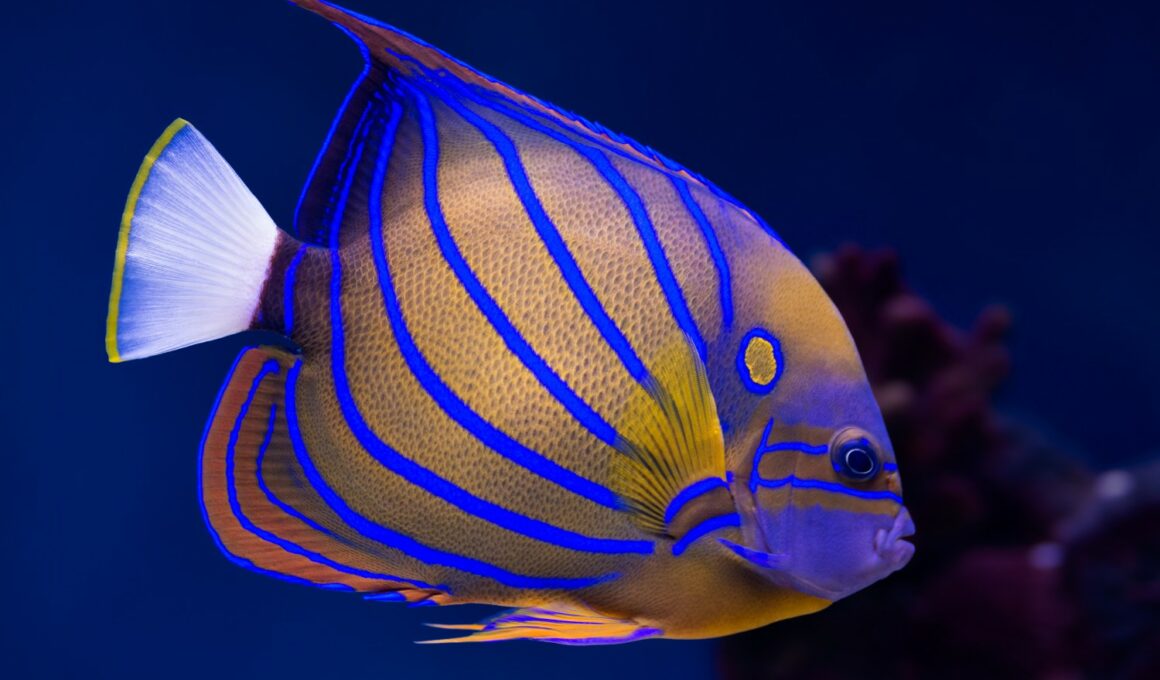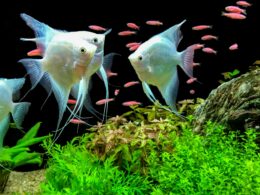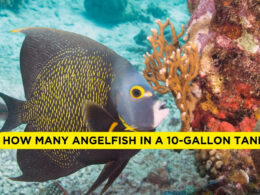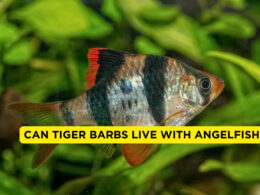In this article Show
If you’re reading this, chances are you’re interested in bringing the majestic Angelfish into your home aquarium—or maybe you’ve already taken the plunge. Either way, you’re in for a rewarding experience.
Angelfish are not only visually stunning but also intelligent and full of personality. However, their gracefulness and beauty come with responsibilities. Proper care is essential for keeping your finned friend healthy and happy.
In this comprehensive guide, we’ll delve into everything you need to know about Angelfish care. From setting up the perfect tank to dietary essentials, lifespan considerations, and even common health issues, we’ve got you covered.
Trust me; I’ve been a fish keeper for years and learned a lot through both research and hands-on experience. Ready to become an Angelfish pro? Let’s dive in.
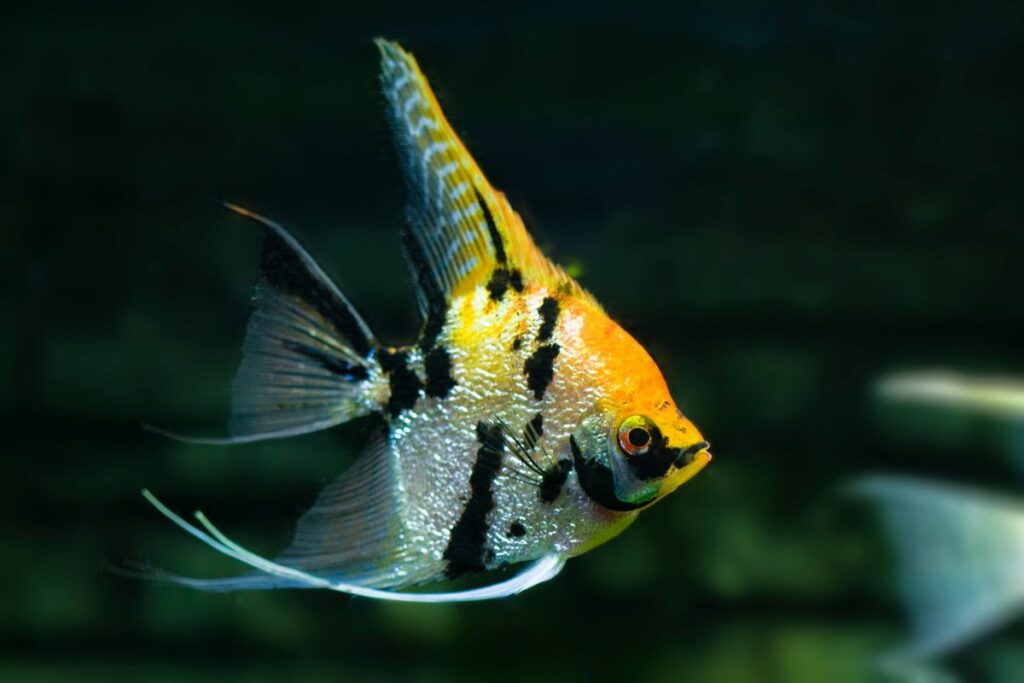
Understanding The Angelfish Species
So, what makes Angelfish so special? Before we get into the nitty-gritty of care routines, it’s essential to understand the unique attributes and origins of these marvelous fish.
Angelfish hail from the Amazon Basin, a lush environment that offers a rich tapestry of aquatic flora and fauna. Picture slow-moving rivers, streams, and floodplains teeming with vegetation—that’s the kind of setting your Angelfish ancestors come from.
Knowing their natural habitat can help you mimic those conditions in your home aquarium, making your Angelfish feel right at home. You might be surprised to learn that Angelfish comes in various types, each with unique patterns and colors.
From the classic Silver Angelfish with its striking black stripes to more exotic variations like Koi or Gold Marble, there’s an Angelfish for every aesthetic preference. However, regardless of the type, their care requirements are broadly similar, which makes things easier for you.
Angelfish are primarily known for their triangular-shaped bodies and long, elegant fins. They’re considered medium-sized aquarium fish, typically reaching up to 6 inches in size. Angelfish are not just pretty to look at; they are also intelligent and can even recognize their caregivers.
They’re somewhat social creatures but also territorial, especially during breeding times. Understanding these basic traits will give you a good foundation for offering them the proper care they need.
Angelfish Lifespan
One of the most common questions I get is, “How long will my Angelfish live?” It’s a crucial question, especially if you’re planning to make a long-term commitment to your aquatic buddy.
When properly cared for, Angelfish can live anywhere from 8 to 12 years in captivity. That’s quite a significant period, especially when compared to other popular aquarium fish. Of course, these are approximate figures; some Angelfish can live even longer, depending on various factors such as water quality.
One of the leading causes of a reduced lifespan is poor water quality. Regular water changes and proper filtration can go a long way in ensuring that your Angelfish lives a long, happy life.
Diet and Nutrition
A balanced diet rich in essential nutrients is vital for Angelfish health and longevity. Poor nutrition can lead to various health issues and a shorter lifespan.
Stress and Environment
Angelfish are sensitive to changes in their environment. Overcrowding, aggressive tank mates, and even abrupt changes in water parameters can induce stress, which, in turn, can adversely affect their lifespan.
Disease
A well-maintained tank and proper care can minimize disease, but illness is always a potential risk. Early diagnosis and treatment are crucial for recovery and longevity.
By now, you should have a good idea about what to expect in terms of the lifespan of your Angelfish and the factors that can influence it. The key takeaway here is that a little effort in proper care can result in a long, fulfilling life for your aquatic pet.
Tank Setup
Alright, now that we’ve touched on the lifespan of Angelfish let’s dive into the heart of the matter: setting up a suitable home for your aquatic friend. Trust me, your Angelfish will thank you for getting these details right.
1. Tank Size
First things first, let’s talk about the size of the tank. Angelfish need room to swim freely and spread their fins, so to speak. For a single Angelfish, a 20-gallon tank is generally considered the minimum.
However, if you’re planning on keeping multiple Angelfish or a community tank, aim for at least a 55-gallon setup.
2. Filtration and Water Movement
Good filtration is a must for any aquarium, but it’s particularly crucial for Angelfish which are sensitive to water quality. A canister filter or a hang-on-back filter usually works well. As for water movement, aim for moderate flow. You don’t want a torrent, but stagnant water is a big no-no.
3. Water Parameters
Now, let’s get into the science stuff—don’t worry, I’ll keep it simple.
- Temperature: Angelfish prefer a warmer environment, ideally between 75°F and 82°F (24°C – 28°C).
- pH Level: Aim for a slightly acidic to neutral pH range, between 6.0 and 7.5.
- Hardness: Soft to moderate water hardness is ideal, ranging from 3 to 8 dKH. Regularly test the water parameters using a reliable test kit, and take corrective actions as needed.
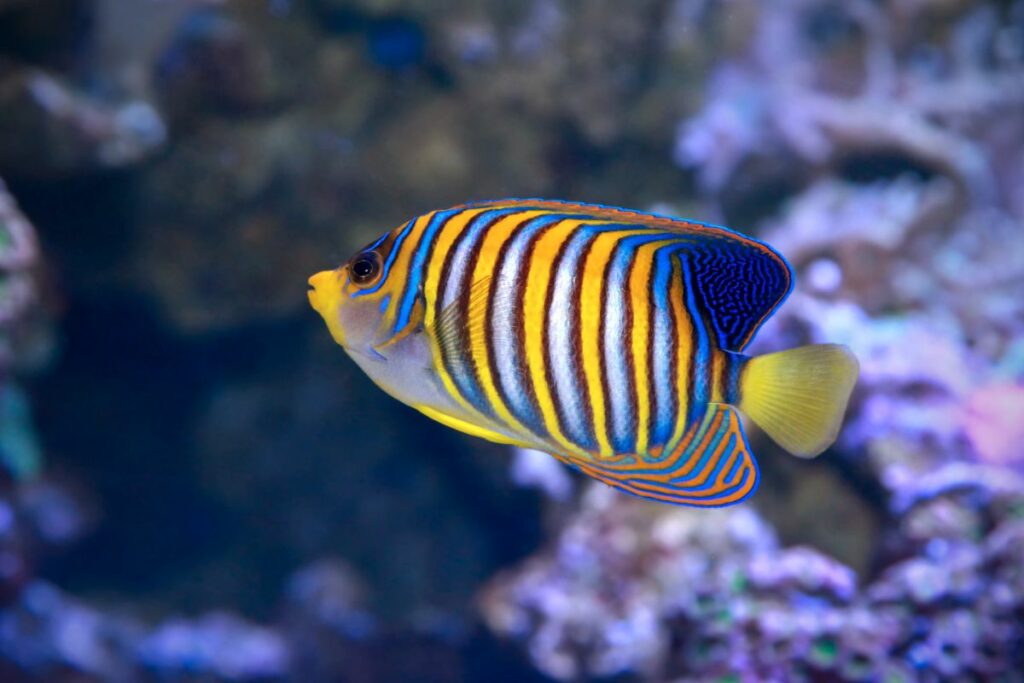
Diet and Nutrition
Now that you’ve nailed the perfect tank setup, it’s time to discuss another cornerstone of Angelfish care: their diet. Trust me, what you feed your Angelfish matters just as much as the environment you provide for them.
1. Types of Food
Angelfish are omnivores, which means they enjoy a mix of plant-based and animal-based foods. Here are some options to consider:
- Live Food: Think brine shrimp, bloodworms, and daphnia. Live foods are rich in nutrients and offer a hunting-like experience for your Angelfish.
- Flakes and Pellets: These are the most convenient options and can serve as a staple diet. However, make sure you buy high-quality products specifically designed for Angelfish or tropical fish.
- Vegetables: You can also offer blanched veggies like spinach or zucchini to supplement their diet.
The key is variety. Switching up their diet not only keeps your Angelfish interested but also ensures they get a broad range of nutrients.
2. Feeding Schedule
Angelfish do well when fed 2-3 times a day. This mimics their natural feeding habits and keeps their metabolism stable. The golden rule here is to feed them only what they can consume in about 2-3 minutes. Overfeeding can lead to water pollution and obesity—yes, fish can get overweight too!
3. Overfeeding Risks
It’s crucial to touch on this. Overfeeding doesn’t just pose health risks for the Angelfish; it can also mess with your tank’s water quality. Uneaten food decays, leading to ammonia spikes that are harmful to all inhabitants of the aquarium.
Common Health Issues
So, you’ve got your tank set up perfectly and your Angelfish are enjoying a balanced diet—great job! However, it’s important to be proactive about their health. Angelfish are relatively hardy, but like all pets, they’re susceptible to certain health issues. Let’s go over some of the most common ones.
1. Ichthyophthirius (Ich)
The symptoms are white spots on the skin, gills, and fins. However, it can be treated by raising the water temperature slightly and treating it with an Ich-specific medication. Ich is one of the most common parasitic infections in freshwater fish, and Angelfish are no exception. Early treatment is crucial.
2. Fin Rot
The symptoms are frayed or discolored fins. Improve water quality and consider antibiotic treatments after consulting with a vet. Fin rot often stems from poor water quality or bacterial infections. Regular water changes can go a long way in preventing this issue.
3. Swim Bladder Disease
The symptoms include difficulty swimming, and floating upside down or on their side. Fasting the fish and then feeding a high-fiber diet can sometimes correct the issue.
While not as common, swim bladder disease can be distressing for both the fish and the owner. Consult a veterinarian for diagnosis and treatment.
4. Nutritional Deficiencies
The symptoms of nutritional deficiencies are faded colors, lethargy, or reduced appetite. Review your Angelfish’s diet and ensure they’re getting a balanced range of nutrients. Nutritional deficiencies can usually be avoided through a well-planned diet, as we discussed in the previous section.
Prevention
The adage “an ounce of prevention is worth a pound of cure” holds true for Angelfish care. Consistently good water quality, a balanced diet, and regular health checks can prevent most of these issues from arising in the first place.
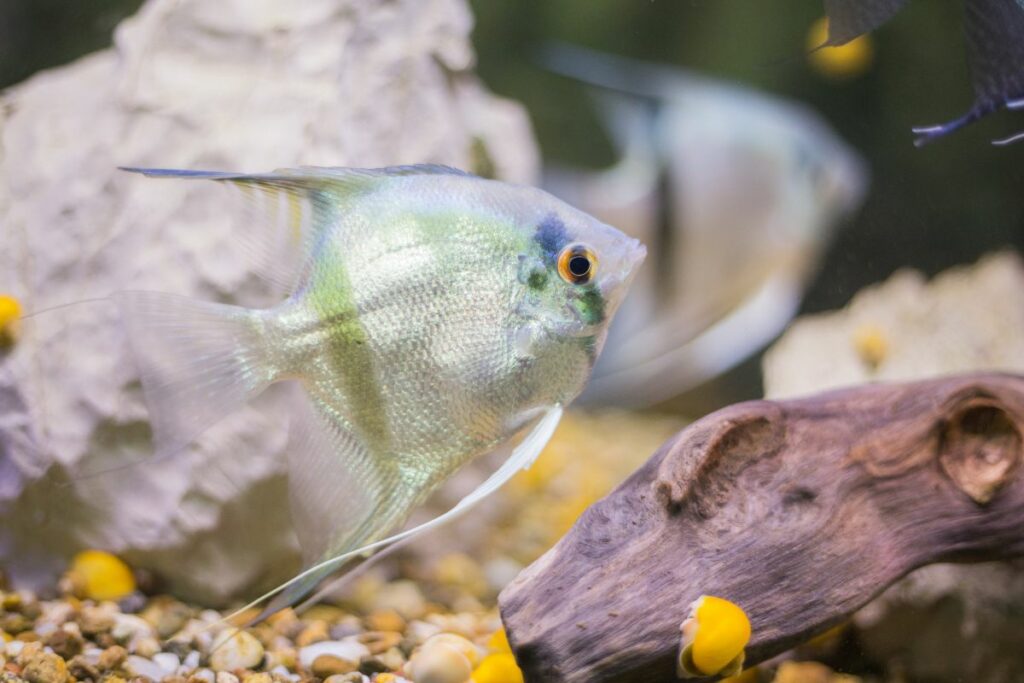
Social Behavior and Tank Mates
You’ve got your Angelfish set up in a beautiful tank, they’re well-fed, and you’re keeping an eye out for health issues. Excellent! But, as social creatures, Angelfish also need the right company to truly thrive. So let’s delve into their social behavior and discuss suitable tank mates.
1. Angelfish Temperament
First things first: despite their heavenly name, Angelfish can sometimes exhibit not-so-angelic behavior. They are generally peaceful but can become territorial, especially during breeding seasons.
Angelfish are often considered community fish, but they do best with species that aren’t too aggressive or too small. If you have multiple Angelfish, you may notice a hierarchy forming. It’s essential to provide plenty of hiding spaces to minimize stress.
2. Suitable Tank Mates
Not every fish species will live harmoniously with Angelfish. Here are some good choices:
- Tetras: Particularly larger tetras like Black Skirt Tetras or Congo Tetras.
- Corydoras Catfish: These bottom dwellers usually mind their own business and won’t bother your Angelfish.
- Mollies and Platies: These are generally peaceful and share similar water condition needs.
3. Tank Mates to Avoid
- Small, Nippy Fish: Avoid small fin-nipping species like some Barb varieties, as they can stress your Angelfish and damage their fins.
- Aggressive Fish: Species like the Red-Tailed Shark or aggressive Cichlids are a no-go; they can bully or even harm your Angelfish.
4. Mixing Angelfish
If you’re planning to keep multiple Angelfish:
- Same-Sized Groups: A group of 5-6 similarly-sized Angelfish usually does well.
- Breeding Pairs: If you intend to breed, keeping a bonded pair is ideal. However, be prepared for increased territorial behavior.
Frequently Asked Questions
Does Angelfish need a filter and aerator?
Yes, Angelfish requires good filtration and moderate water movement for optimal health. Both a filter and an aerator can help achieve this.
How often should I feed my Angelfish?
Angelfish do well when fed 2-3 times a day, consuming what they can in about 2-3 minutes.
Does Angelfish need a filter and aerator?
Yes, Angelfish requires good filtration and moderate water movement for optimal health. Both a filter and an aerator can help achieve this.
Conclusion
So there you have it—a comprehensive guide to Angelfish care, covering everything from tank setup and diet to social behavior and common health issues. Armed with this knowledge, you’re well on your way to providing a happy, healthy home for these fascinating creatures.
Remember, the key to successful Angelfish keeping lies in a balanced approach that includes a well-maintained environment, a nutritious diet, and proper social interaction. It might seem like a lot to take in, but trust me, the reward of seeing your Angelfish thrive is worth every effort. Happy fish keeping!






